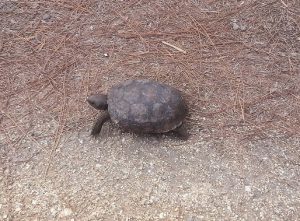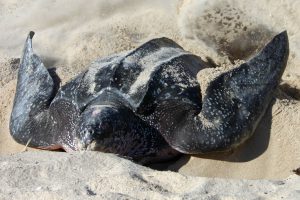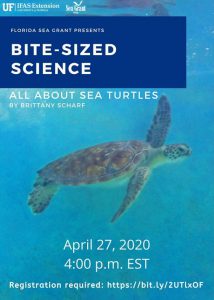There are two species of reptiles that you might have heard about recently here in Florida: the gopher tortoise and the leatherback sea turtle. One species can be found on land while the other spends its entire life in the ocean. Let’s learn more about these two native, but very different reptiles!
Gopher Tortoise
Behavior and Habitat
Gopher tortoises, Gopherus polyphemus, are found in habitats with well-drained, sandy soils such as longleaf pine sandhills, xeric (meaning very dry) oak hammocks, scrub, pine flatwoods, dry prairies, and coastal dunes. They are also common in pastures and urban areas. You might even have one or two living in your neighborhood.

In addition to the shells on their backs, gopher tortoises dig burrows for protection. These burrows average 15 feet in length and can go 6 ½ feet deep into the ground. Gopher tortoises do not stray far from their burrows. In fact, they spend up to 80% of their time inside of their burrows and forage for low-growing plants within 160 feet of their burrow.
Did you know that gopher tortoises burrows serve as shelter and refuge for more than 350 other species, called commensals? Burrowing owls, Florida mice, indigo snakes, rabbits, gopher frogs, and all kinds of invertebrates are just some examples of commensals. The gopher tortoise is considered a keystone species because so many species rely on their burrows.
Keystone species are a vital part of an ecosystem. Removing a keystone species can be detrimental to other species who rely on them. They help hold the ecosystem together so that it functions properly. Without them the ecosystem is off balance.
Conservation Status

Unfortunately, the population of gopher tortoises is decreasing. In Florida, it is a state-designated threatened species. It is unique in that it is federally listed as threatened under the Endangered Species Act, but only in the portion of its range occurring west of the Mobile and Tombigbee Rivers in Alabama. In the eastern portion of its range, the gopher tortoise is a candidate species for federal protection.
April 10th every year is designated as Gopher Tortoise Day! This is one day a year where this species is celebrated! The goal of Gopher Tortoise Day is to increase awareness and appreciation for this gentile reptile. Did you celebrate gopher tortoises this year?
Leatherback Sea Turtle
Behavior and Habitat
Leatherback sea turtles, Dermochelys coriacea, are the largest turtle in the world. They can grow to be 6 feet long and can weigh up to 2,000 pounds. Unlike other sea turtles, leatherbacks have black, tough, and rubbery skin. Their shell, called a carapace, is softer than other sea turtles’ and does not have scales or “scutes”. The carapace has seven ridges along the length that function together like an accordion. This enables leatherback sea turtles to dive deep to find food. They use their large flippers to travel long distances. They migrate the farthest of any sea turtle, averaging 3,700 miles between their breeding and feeding grounds!

Leatherback sea turtles dive very deep, up to 4,200 feet, deeper than any other turtle, and can stay down for up to 85 minutes. And, unlike other sea turtles, they can regulate their body temperature to survive the cold waters that they encounter. Even though they are the largest turtle in the world, they feed primarily on jellyfish. They eat and swallow jellyfish by using their scissor like jaws and the stiff, backward-pointing spines lining their throat cavity.
Like all sea turtles, they spend most of their lives in the ocean, except when females come a shore to lay their eggs. Females nest on the beach primarily on the east coast of Florida usually from March until July, with peak nesting occurring around May. Females lay on average 73 fertilized eggs and 25 yolkless eggs called spacers in each nest. They will come ashore multiple times per season to lay a clutch of eggs. Females return to nest every 2 to 3 years. About 50% of the leatherback nesting in Florida occurs in Palm Beach County. However, Canaveral National Seashore in Brevard and Volusia counties and Archie Carr National Wildlife Refuge in Brevard and Indian River counties also see a couple of leatherback nests each year.
Conservation Status
As with the gopher tortoise, the number of leatherback sea turtles has declined. The Endangered Species Act protects them as a federally designated endangered species. Florida’s Marine Turtle Protection Act protects them as well. The primary threat to the leatherback is entanglement in fishing gear. Some countries harvest the meat and eggs illegally.

It is illegal to approach or disturb a nesting sea turtle. For updates on sea turtle nesting in our area, be sure to follow the Canaveral National Seashore and the UCF Marine Turtle Research Group. Canaveral National Seashore had their first leatherback nest on April 8, 2020. As of April 10, 2020, the UCF Marine Turtle Research Group has documented 10 leatherback nests in the Brevard County portion of the Archie Carr National Wildlife Refuge.

You can learn more about sea turtles during a Florida Sea Grant Bite-Sized Science webinar on April 27th at 4pm EDT. You can register for that webinar plus many more at http://bit.ly/bite-sizedscience
Other References:
https://myfwc.com/wildlifehabitats/profiles/reptiles/sea-turtles/leatherback-turtle/
Reviewed and edited by Maia McGuire, Brittany Hall-Scharf, and Gayle Whitworth
 0
0
